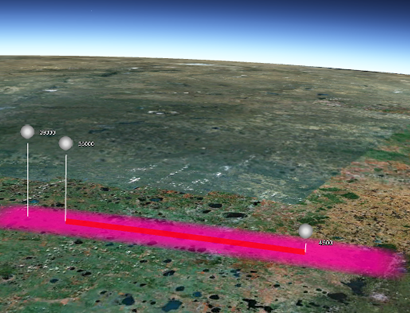SketchUp helped assess the speed of the Chelyabinsk phenomenon
 Using the simulation in SketchUp, it was possible to approximately restore the track of the object, observed on February 15, 2013 over the South Urals, and to assess its height profile and, most importantly, speed relatively accurately. Obviously, what happened over the South Ural is a threat; its character depends on the nature of the object: whether it is of natural origin or artificial. This is the main question.
Using the simulation in SketchUp, it was possible to approximately restore the track of the object, observed on February 15, 2013 over the South Urals, and to assess its height profile and, most importantly, speed relatively accurately. Obviously, what happened over the South Ural is a threat; its character depends on the nature of the object: whether it is of natural origin or artificial. This is the main question.Until fragments of an object have been found, speed can help clarify its nature. The average speed of natural celestial bodies (20 km / s according to a study for the National Security Council of 1989), regularly entering the Earth’s atmosphere, is much higher than typical for spacecraft values of 8-11 km / s.
To determine the speed, we used the video, which appeared in abundance; The collection of links to cameras located in the geographical space was provided by the user siberiano - thank you for your help.
At the first stage of the restoration, two videos were selected - one was made in Kamensk-Uralsky (140 km north of Chelyabinsk), the other in Magnitogorsk (240 km south-west). They were selected according to the most important condition for 3D modeling - the presence of suitable buildings and structures in the frame.
In SketchUp, 3D-models of buildings and structures captured in frames were recreated, the cameras were restored with possible accuracy, and rays were built towards the object at different stages of flight. The models were exported to Google Earth - the flight path was restored (in the first rough approximation).
The accuracy of determining the route of the object in this way is low - it is clear only that it was methyl in Miass, and for some reason the maximum energy release fell on Chelyabinsk. But it is possible to determine the average speed along the length of the path and the time of movement of the object with accuracy that is quite acceptable for the first estimates.
The site covered a distance of 150 km in 15 seconds, which gives an average speed of about 10 km / s. So if this is a car, it is very, very slow, which is remarkable in itself.
At the same time, the object decreased from approximately 40 km, where its luminescence was first noted, to 4.5 km.
Work on the modeling is expected to continue; its main current goal - perhaps the exact restoration of the trajectory and analysis of the features - there is also a lot of curious. We will be grateful for the help with the original data - video recordings and photographs, precisely localized in the geographical space. Data from several more "successful" cameras are waiting for processing.
You can download the current model of the Chelyabinsk phenomenon in the KMZ format . Short description is here .
')
Source: https://habr.com/ru/post/169857/
All Articles